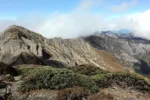Bear safety tips for hikers
This post may contain affiliate links. This means that we may receive a small commission from purchases through those links. Read more in our affiliate disclosure.
Bears are magnificent creatures, but they can be unpredictable and dangerous. Some bears may be curious, others indifferent, but in some cases, they can be aggressive, especially when they feel their cubs or food source is threatened. Learn here how to safely navigate bear country, while respecting these animals in their natural habitat.
When hiking in bear territory, always look out for signs of bears like tracks and scat. Carry bear spray and know how to use it swiftly. Make consistent noise, like with a bear bell, to prevent surprise encounters, and store all food in bear-proof containers. If you encounter a bear, stay composed, gently announce your presence, and prepare to use bear spray if the situation escalates. In case of an attack, your response should be based on the bear’s behavior and species: Play dead during a defensive attack of a brown bear; fight back viciously if it’s a black bear or a predatory attack.
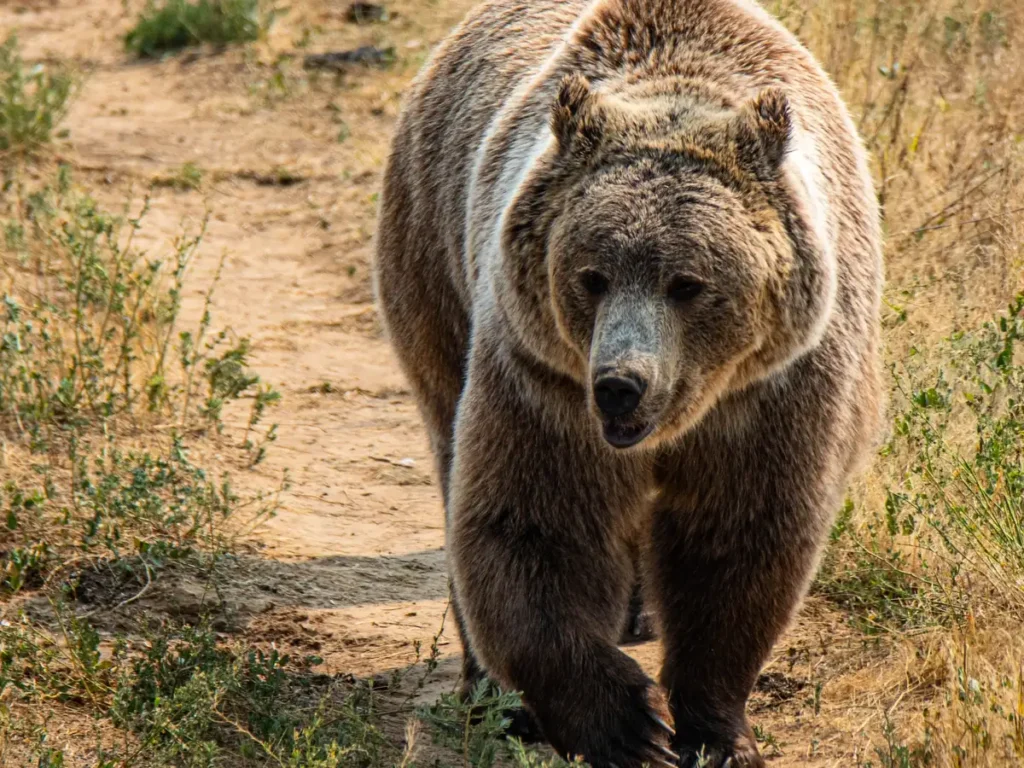
- Introduction
- The Different Types of Bears
- How to prepare for a Hike in Bear Country
- How to Recognize Bear Presence and Behavior
- Preventing Bear Encounters While Hiking
- What to Do If You Encounter a Bear
- Handling Bear Attacks
- Bear Safety While Camping
- Conclusion
The Different Types of Bears
Each bear species has distinct characteristics and behaviors that can influence how you should react in their presence. The most important types of bears, sorted by region, are:
North American Bears
Black Bears
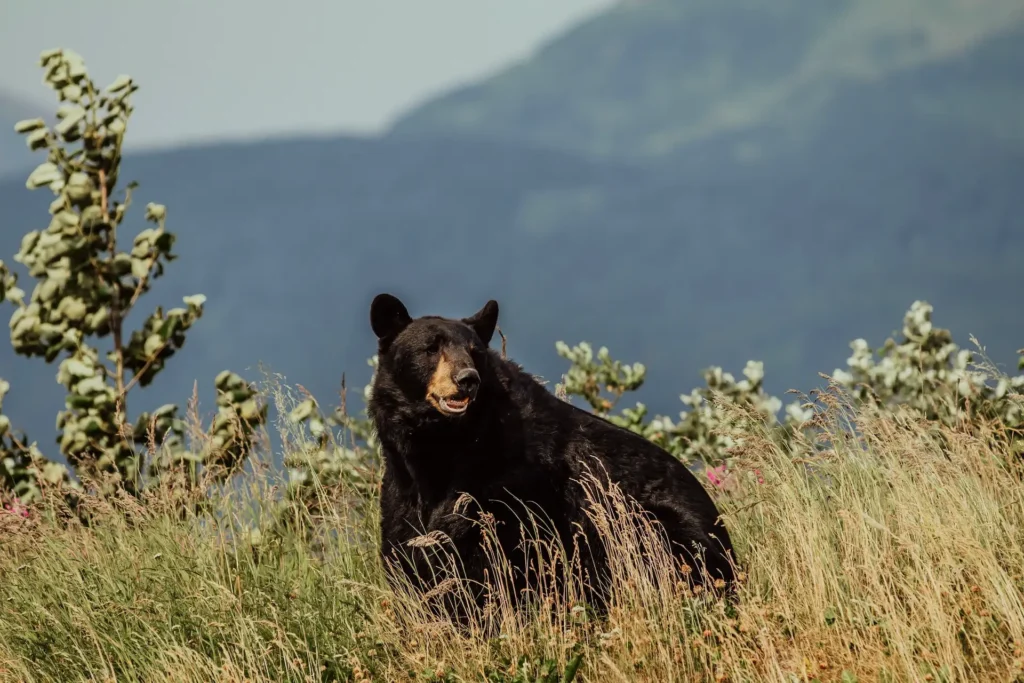
- Habitat: Widely distributed across North America
- Color: Variations from black to light brown
- Behavior: Generally avoidant of humans, can be dangerous around cubs
Black bears are the most commonly encountered bear species in North America. Despite their name, their fur can range in color, sometimes leading to confusion with other species. They are less aggressive than grizzly bears but still require caution, especially if they feel threatened or are with their cubs.
Brown (Grizzly) Bears
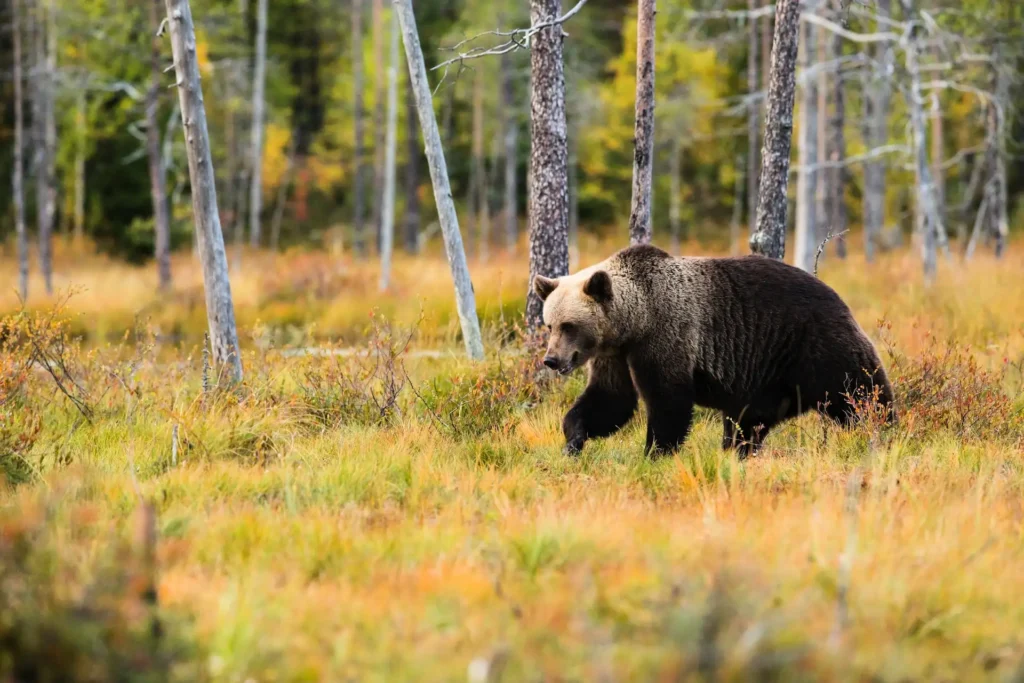
- Habitat: Western United States, western Canada, Alaska
- Identifying Feature: Prominent shoulder hump
- Behavior: Known for strength, can be aggressive
Grizzly bears are larger and typically more aggressive than black bears. The key distinguishing feature is the noticeable hump on their shoulders. These bears command a great deal of respect due to their size, strength, and potential for aggression, particularly when startled or with cubs.
Eurasian Bears
Eurasian Brown Bears
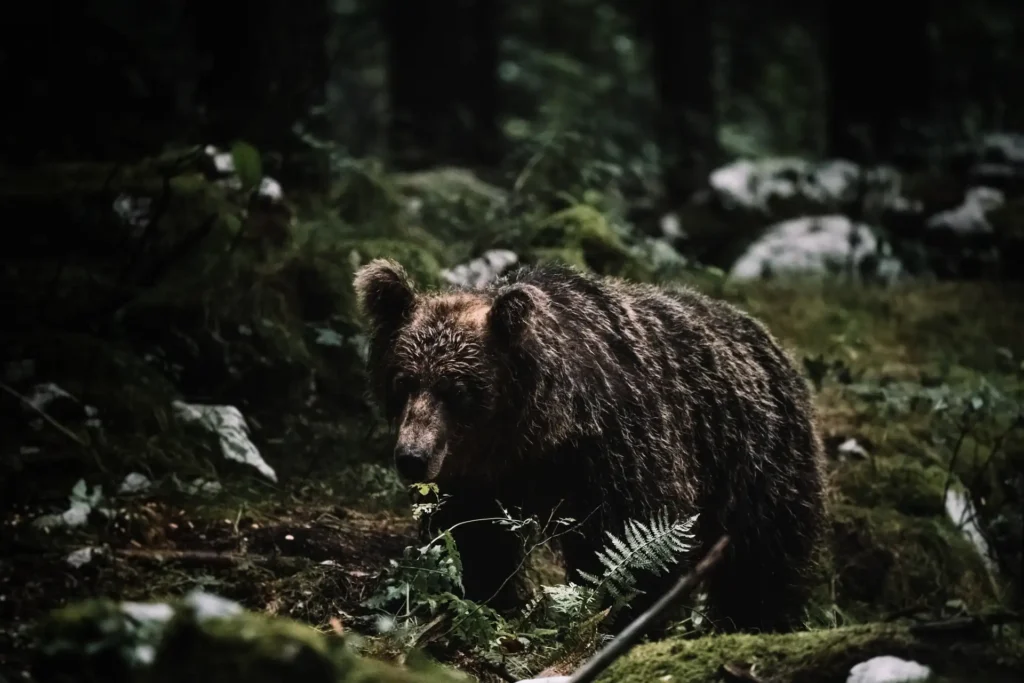
- Regions: Scandinavia, Eastern Europe, Russia, Balkans
- Characteristics: Similar to North American brown bears
- Human Interaction: Less aggressive, but caution advised
Euroasian brown bears are closely related to North American brown bears but tend to be less aggressive. However, encounters are less frequent, and caution is still advised, particularly in remote areas.
Asian Black Bears
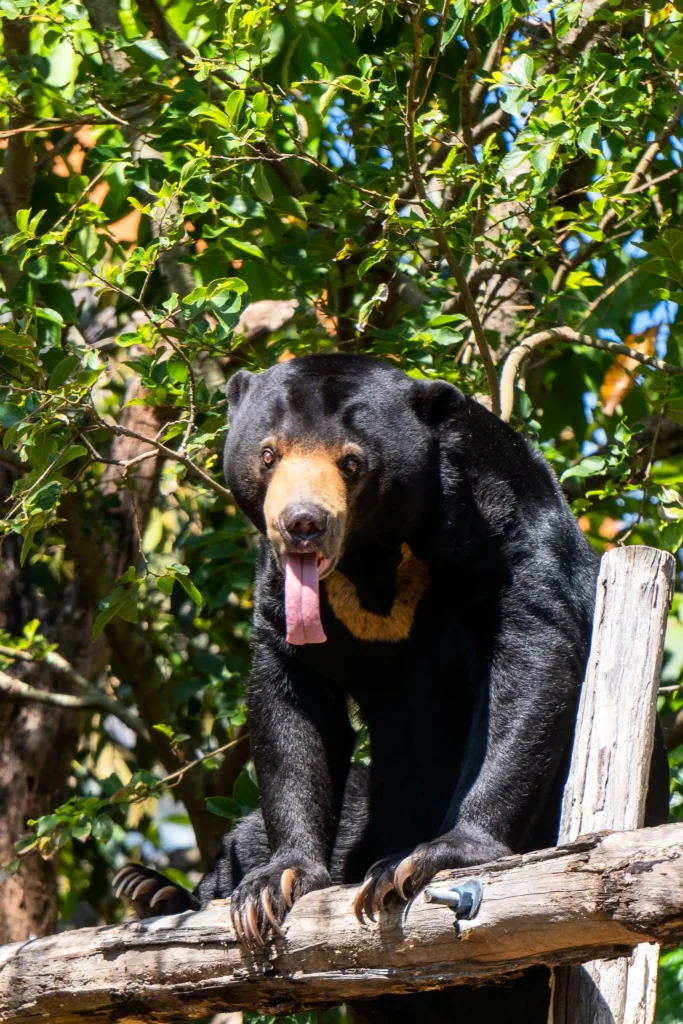
- Regions: Russia’s Far East, China, Korea, Japan, Himalayas
- Features: Black fur, distinctive white chest patch
- Behavior: Aggressive, especially in areas with less human interaction
Also known as “moon bears,” Asian black bears are noted for their unpredictable nature. They are particularly aggressive in regions where they are not accustomed to human presence, requiring hikers to be
Bears in Japan
Ussuri Brown Bears in Hokkaido
- Habitat: Northern island of Hokkaido
- Relation: Close to North American Grizzly Bear
- Caution: Unpredictable and potentially aggressive
In Japan, particularly in Hokkaido, hikers may encounter the Ussuri brown bears. These bears are closely related to the North American grizzly bear and are known for their unpredictability and potential aggression.
Himalayan Region
Himalayan Brown Bear
- Habitat: Higher regions of the Himalayas
- Appearance: Generally lighter in color
- Interaction: Scarce but potentially aggressive
Himalayan brown bears are a rarer species encountered in the high altitudes of the Himalayas. They are generally lighter in color than other brown bear species. Encounters are rare, but these bears can be aggressive, especially in remote areas.
How to prepare for a Hike in Bear Country
By taking the right steps before and during your hike, you can significantly reduce the risk of bear encounters and ensure a safe experience. Here’s what you need to consider:
Research and Alerts
Check for Bear Activity
Before embarking on your hike, research recent bear activity in the area. This can be done through online resources, such as park websites or wildlife management databases. Pay attention to any reports of bear sightings, closures due to bear activity, or warnings issued by park authorities. This information can help you choose the safest trails and times for your hike.
Trailhead Signage
Once you arrive at the trailhead, take a moment to read any posted signs or notices. These often contain crucial information about recent bear sightings, advice on how to handle encounters, and specific area restrictions.
Essential Gear
Bear Spray
Bear spray is a non-lethal deterrent proven to be effective in stopping aggressive bear behavior. It’s important to select EPA-approved bear spray with a sufficient range (usually around 30 feet). Equally important is knowing how to use it – practice with an inert canister and ensure it’s readily accessible, such as in a holster on your hip or shoulder strap.
Noise-Making Devices
You need to be loud in order to avoid surprise bear encounters. You can make noise by talking loudly or clapping, but it’s better to bring bear bells or whistles.
Bright Clothing
Wearing brightly colored and easily visible clothing can help you stand out in the natural environment. This is not only helpful for other hikers to spot you but can also make you more noticeable to bears, who may then choose to avoid you.
Avoid Heavy Fragrances
Bears have an acute sense of smell. Perfumes, scented lotions, and other fragrant products can attract their curiosity. Opt for unscented products and try to keep any odors to a minimum.
Food Storage
All food, garbage, and scented items should be stored in bear-proof containers or hung properly between trees, well away from your sleeping area. This prevents bears from being attracted to your campsite or trail.
Route Planning
Select Bear-Smart Trails
Choose trails that are less likely to encounter bears. This means avoiding trails that pass through dense berry patches, salmon streams, or other natural bear food sources. Additionally, trails with good visibility and fewer dense underbrush areas are preferable.
Hike in Groups
Bears are less likely to approach larger groups of people. The recommended group size is 3 or more. Hiking in groups not only deters bears but also means more eyes and ears to spot signs of bear presence.
Stay Together
When hiking in a group, stay close together, especially in dense vegetation or areas with limited visibility. This ensures that the group appears larger to a bear and helps in maintaining effective communication among all group members.
Inform Someone
Always let a reliable person know your hiking plan, including the trails you plan to take and your expected return time. In case of an emergency, this information can be vital for rescue operations.
How to Recognize Bear Presence and Behavior
Effectively recognizing signs of bear presence and understanding their behavior is vital for safety and respect in bear country. This comprehensive understanding enhances your outdoor experience and safety. Let’s delve into the details:
How to identify Bear Signs
Tracks
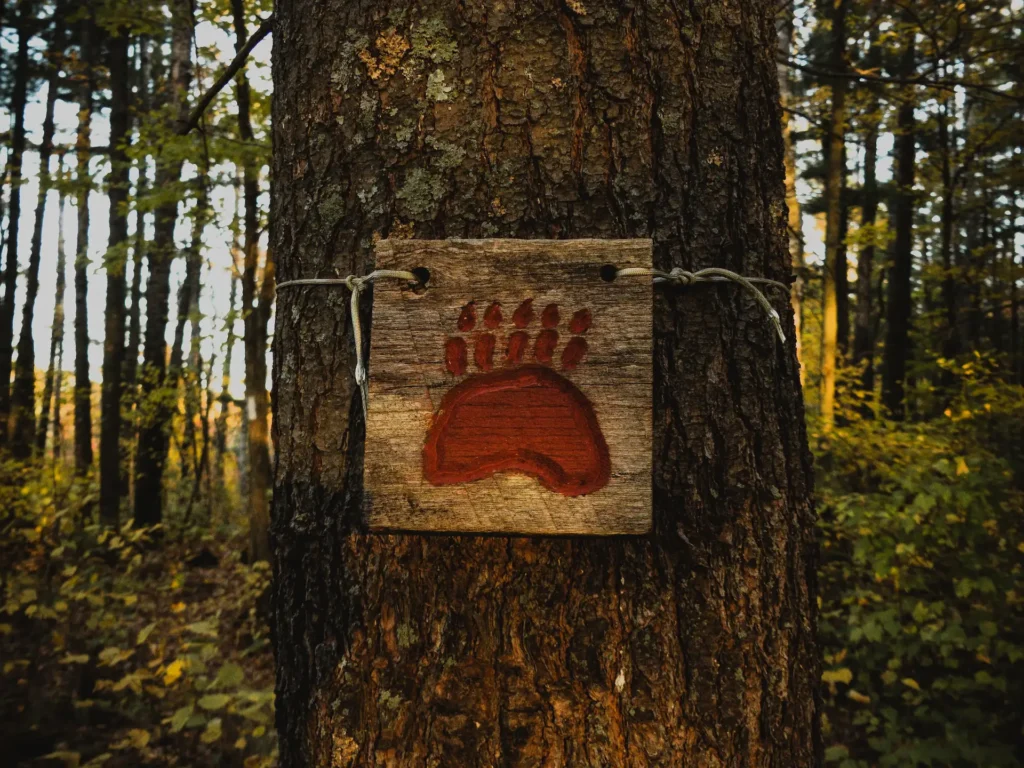
Bear tracks are a definitive sign of their presence in an area. The front paw prints of a bear are similar to a human handprint, but with elongated fingers, while the hind tracks more closely resemble an elongated human footprint. The tracks of a grizzly bear are generally larger with more pronounced and separated claw marks, compared to the smaller and closer claw marks of black bears. The pattern of the tracks can also be telling; a straight line indicates a bear moving with a purpose, such as traveling to a food source, while a wandering pattern might suggest the bear is foraging.
Scat
Bear scat is another good indicator and varies in appearance based on the bear’s diet. It often contains visible remnants of what the bear has been eating, such as berries, nuts, or animal remains. The size and shape of the scat can also help in identifying the species; larger, tubular scat often belongs to a grizzly, while smaller, pellet-like scat is more characteristic of black bears. The presence of scat, especially if it’s fresh, indicates recent bear activity in the area.
Tree Scratches
Bears frequently scratch trees, which serves multiple purposes including marking territory, communication, and claw sharpening. These markings are typically vertical scratches on tree trunks and can vary in height and depth. In areas with higher bear populations, multiple trees in a vicinity may have these markings. Recognizing these signs not only indicates bear presence but can also give insights into bear behavior in that region.
Foraging Signs
Signs of bear foraging include disturbed vegetation, dug-up ground, and overturned rocks or logs. Bears, especially in preparation for hibernation, actively search for food and can leave behind noticeable signs of their feeding activities. Recognizing these signs helps in understanding bear movements and preferred feeding areas, which can be crucial for avoiding encounters.
Rub Trees
Bears rub against trees to leave their scent, which is a form of communication with other bears. These trees often show signs of wear and may have bear fur stuck to them. The presence of rub trees indicates an area frequently traversed by bears and can serve as a warning to hikers to be extra vigilant.
Bear Behavior
Curiosity vs. Aggression
A bear standing on its hind legs is often a sign of curiosity, not aggression. In this posture, a bear is trying to get a better view and catch scents. However, even a curious bear can become aggressive if it feels threatened.
Defensive Behavior
A bear displaying defensive behavior, such as making bluff charges, making loud noises, or swatting the ground, typically wants more space. This behavior is often a response to a perceived threat, and the bear is trying to intimidate without engaging in a physical confrontation. Giving the bear space and slowly backing away can help de-escalate the situation.
Predatory Behavior
Although rare, bears can exhibit predatory behavior, characterized by silent, intent following or stalking. This behavior requires immediate and decisive action, as it can pose a significant threat to hiker safety. Understanding the difference between a bear’s curiosity and predatory behavior is crucial for making the right decisions during encounters.
Mother and Cubs
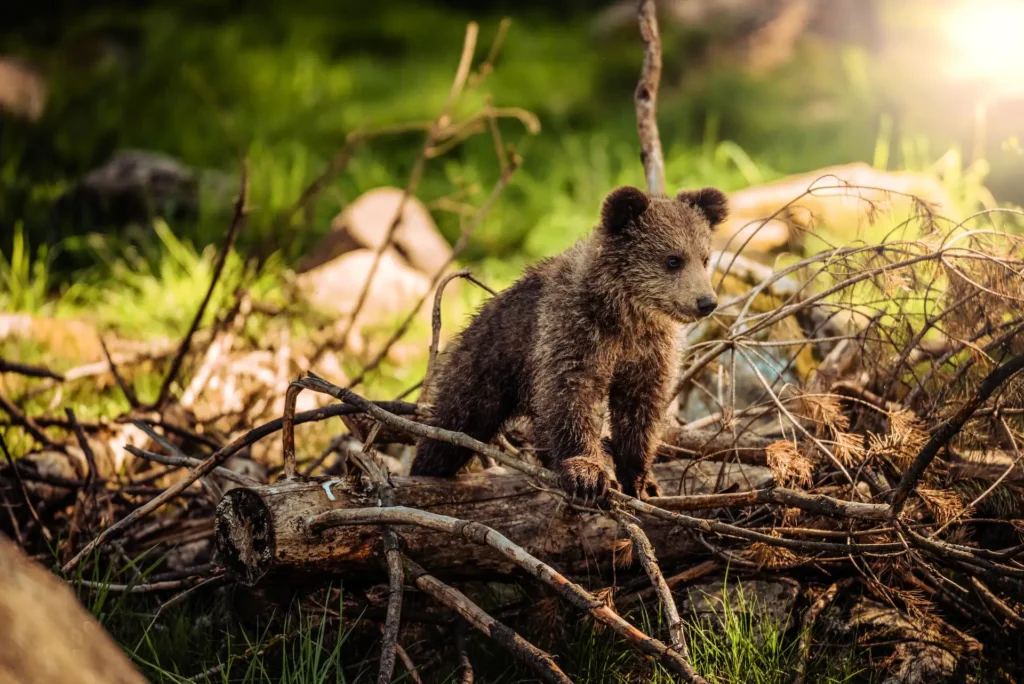
Female bears with cubs are particularly protective and can be more aggressive if they perceive a threat to their offspring. In a whole 70% of brown bear attacks, the reason was a mother protecting her cubs! Give these bears a wide berth and to NEVER come between a mother and her cubs at all costs.
Preventing Bear Encounters While Hiking
While it’s impossible to completely eliminate the risk, there are effective strategies you can employ to significantly reduce your chances of coming across a bear. Here’s a detailed look at how to prevent bear encounters while on the trail:
Make Noise on the Trail
Noise-Making Devices
By carrying and using noise-making devices such as bear bells, whistles, or even a loud voice, you can alert bears to your presence. Bears generally prefer to avoid humans, so making consistent noise can help prevent surprise encounters. In dense or loud environments, such as near running water, you need to make louder noises to be heard.
Human Voices as Deterrents
Regular conversation, singing, or calling out at regular intervals are also effective. The human voice is unique and can alert bears from a distance. This is especially useful in areas with limited visibility, where bears might not see you until you’re close.
Avoid Bear Attractants
Steer Clear of Food Sources
Be aware of natural bear foods in the area, like berry patches or fish streams, and avoid hiking near these spots, especially during peak feeding times for bears. Also, steer clear of carcasses, as bears may be nearby or return to the carcass.
Proper Food Handling
When carrying food, use odor-proof bags and containers. Dispose of all food waste properly, and never leave food unattended. Cooking and eating away from your sleeping area can also help reduce the risk of attracting bears to your campsite.
Trail Vigilance
Stay on Designated Trails
Using well-established and marked trails can reduce the likelihood of stumbling upon a bear. These trails are often clear of dense vegetation, providing better visibility for you and the bears.
Avoid Dense Vegetation and Blind Spots
Be extra cautious in areas with dense brush, berry thickets, or blind corners. These are places where bears might not see or hear you coming. In such areas, increase your noise-making efforts and proceed cautiously.
Hike During Safe Hours
Avoid hiking at dawn, dusk, or night when bears are most active. These times not only increase your chance of an encounter but also make it more difficult for you to spot bears.
What to Do If You Encounter a Bear
Even with the best preparation and preventative measures, bear encounters can still happen. Here’s a detailed guide on handling bear encounters, tailored to different scenarios:
Non-threatening Encounters
Remain Calm and Assess the Situation
If you spot a bear that hasn’t noticed you or seems uninterested, stay calm. Assess the bear’s behavior and distance. If possible, quietly back away and leave the area. Avoid sudden movements or running, as this can trigger a chase response in bears.
Make Yourself Known
If the bear has seen you, speak in a calm, firm voice, and slowly wave your arms to make yourself look bigger. Often, bears will leave once they recognize you as human. Do not turn your back or run, as this can provoke an attack.
Close Encounters
Do Not Run
Running can trigger a predatory response in bears. Instead, stand your ground, or back away slowly if you can. Prepare to use your bear spray if the bear approaches.
Your main focus should be to stay far enough from the bear that it can’t attack you. Don’t play dead quite yet – a black bear might approach out of curiosity, and then injure you when startled.
Also, don’t try to climb a tree. Here’s an old saying about that –
When you’re chased by a bear and you don’t know what kind it is, climb a tree.
If the bear climbs the tree after you and kills you, it was a black bear.
If the bear knocks the tree down and kills you, it was a grizzly.
Use Bear Spray Effectively
If a bear comes within your personal space (usually within 30 feet), this is the time to use bear spray. Aim slightly downward, as the spray will rise, and create a cloud that the bear must pass through. Spray when the bear is about 20-30 feet away, or if it charges.
Handling Bear Attacks
There’s a famous rhyme about how to react to bear attacks:
If it’s brown, lay down. If it’s black, fight back. If it’s white, goodnight.
Thishandy mnemonic is mostly true, but misses some details. Depending on whether a bear attack is defensive or predatory, you need to react differently. Here’s an in-depth look at how to handle various types of bear attacks:
Types of Attacks
Defensive Attacks
Defensive attacks usually occur when a bear is surprised, feels threatened, or is defending its cubs or food. In these cases, the bear’s goal is not to prey but to neutralize what it perceives as a threat. The bear may make loud noises, bluff charge, or swat the ground before attacking.
Predatory Attacks
Predatory attacks are rare and occur when a bear actively stalks or follows a human, indicating it sees the human as prey. This behavior requires immediate and aggressive defense.
Black Bear Attacks
Fight Back
In the rare event of an aggressive encounter with a black bear, fight back. Black bears are usually less aggressive than grizzly bears, and showing aggression can often persuade them to back off.
Use Weapons or Objects
If available, use any object as a weapon. Sticks, rocks, or even hiking poles can be used to strike the bear. Aim for the bear’s face, particularly the eyes and nose, where it is most sensitive.
Continuous Aggression
Continue to fight and make noise. Black bears are often intimidated by loud, aggressive responses and might choose to flee.
Grizzly Bear Attacks
Defensive Behavior
In a defensive attack, your best strategy is to play dead, especially if the bear knocks you down. Lie flat on your stomach, clasp your hands behind your neck, and use your elbows and spread your legs to make it harder for the bear to flip you over.
Remain Still
Stay as still as possible and protect your vital areas. Most defensive attacks by grizzly bears are short and cease once the bear feels the threat is neutralized.
Fight Back if Necessary
If the attack continues or you believe it is a predatory attack, fight back with everything you have. As with black bears, aim for sensitive areas like the face, using any available objects or your limbs.
Bear Safety While Camping
Camping in bear country requires extra precautions to ensure your safety and the safety of the bears.
How to Select a Campsite
Look for campsites that are not near natural bear paths or feeding areas, such as berry patches or streams with fish. Elevated, open areas with good visibility are best.
Set up your sleeping area at least 100 yards away from your cooking area and food storage. This helps to keep food odors away from where you sleep, reducing the risk of attracting bears to your tent.
Food Storage and Management
Use bear-proof containers to store all your food, toiletries, and anything with a scent. These containers should be sealed and stored a safe distance from your sleeping area.
Many campsites in bear country provide bear lockers. Use them to store your scented items securely. Ensure the locker is properly closed and latched.
Cook simple meals that don’t produce strong odors. Clean up immediately after meals, and never leave food unattended. Dispose of wastewater far from your campsite.
Campsite Maintenance
Maintain a clean campsite. Promptly and properly dispose of all trash in bear-proof trash receptacles. Avoid leaving any food scraps or litter around.
Store toiletries just as securely as food. Bears are attracted to odors from products like toothpaste, soap, and lotions.
Cook and eat in clothing different from what you sleep in. Store your “cooking clothes” with your food and toiletries to minimize the risk of bringing food odors into your tent.
Avoid storing any food or scented items in your tent. If you’ve had a bear encounter during the day, consider moving your camp to a new location.
Conclusion
Safely enjoying the wilderness in bear country hinges on thorough preparation, a deep understanding of bear behavior, and vigilant practice of safety measures.
Keep an eye out for signs of bear presence, such as tracks and scat, and understand the different behaviors exhibited by various bear species. Carry and know how to effectively use bear spray, make noise to avoid surprise encounters, and practice safe food storage in bear-proof containers. With these practices, hikers and campers can respect and coexist with these magnificent creatures while exploring the great outdoors.


